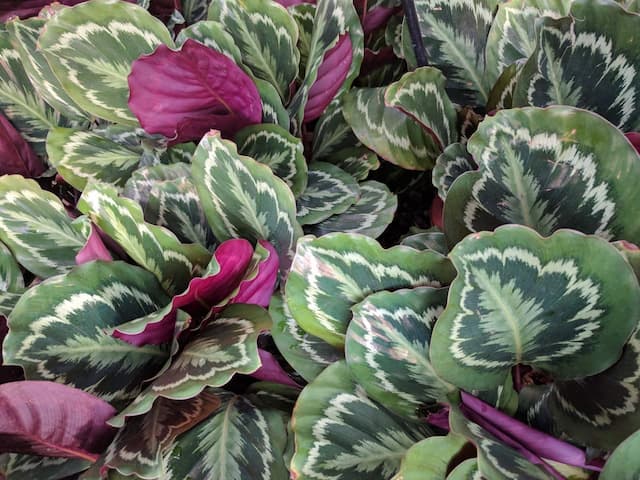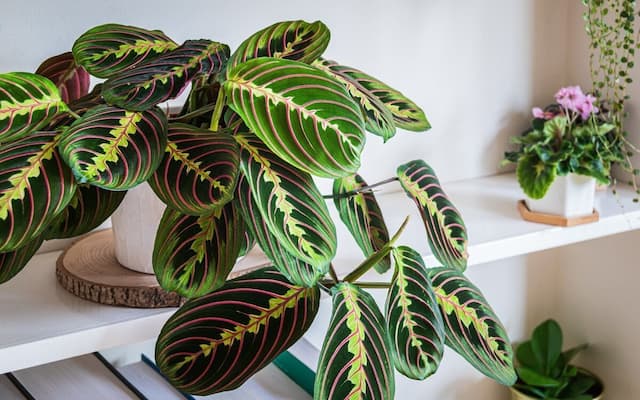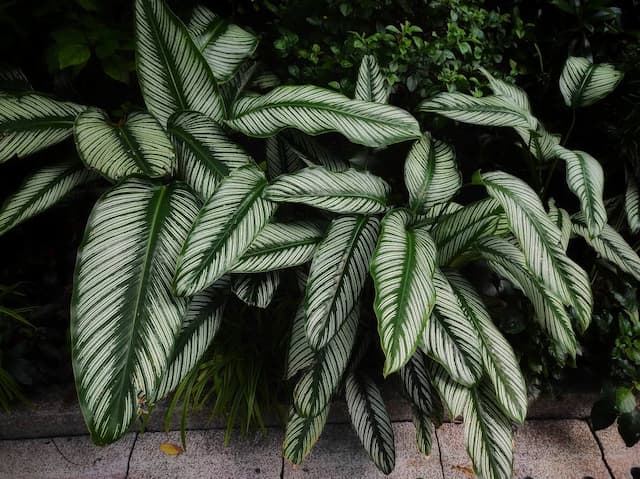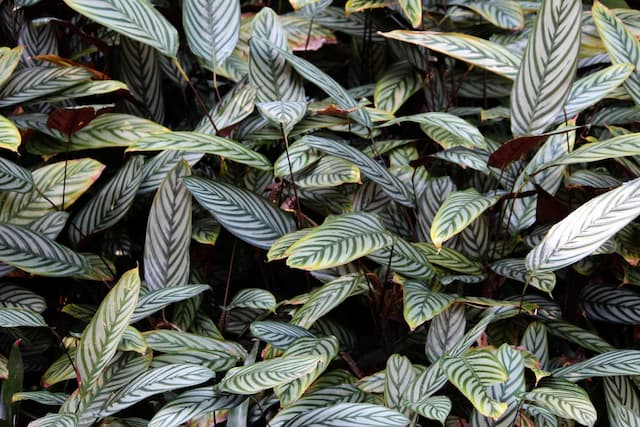Triostar Stromanthe sanguinea

ABOUT
The plant known as Stromanthe sanguinea, also commonly called the Triostar Stromanthe, is noted for its striking and ornamental foliage that contributes to its popularity as a houseplant. The leaves are its most remarkable feature, with a unique coloration that makes this plant easily recognizable. Each leaf is a work of art, displaying an array of colors. The top side of the leaves flaunts a glossy green color with variegations of cream and light pink, while its underside reveals a deep, rich magenta or purple shade. The blend of colors gives the leaves a multicolored, almost painted look. These distinctive leaves are oval to lance-shaped with a pointed tip and can appear to be slightly wavy or even curly along the edges, adding to the dynamic texture of the plant. The leaves are attached to long, slender stems that arch gracefully, giving the Triostar Stromanthe a lush and tropical appearance. In optimal conditions, small white flowers may bloom, but the plant is principally grown for its attractive foliage rather than its blooms. The overall visual appeal of the Triostar Stromanthe is one of vibrant color and elegant leaf structure, making it an aesthetically pleasing addition to any plant collection or interior space.
About this plant
 Names
NamesFamily
Marantaceae
Synonyms
Tricolor Stromanthe, Triostar, Magenta Triostar
Common names
Maranta sanguinea, Phrynium sanguineum, Stromanthe thalia, Stromanthe thalia var. sanguinea.
 Toxicity
ToxicityTo humans
The Stromanthe sanguinea, commonly known as the Tricolor Stromanthe, is not considered toxic to humans. Ingesting parts of this plant typically does not result in poisoning or serious health consequences. However, it's always advisable to prevent children from eating plants as a general safety precaution.
To pets
The Tricolor Stromanthe is non-toxic to both cats and dogs. If your pet ingests parts of this plant, it is unlikely to experience poisoning or severe health effects. However, ingestion might potentially cause mild gastrointestinal discomfort due to the unusual plant matter, but toxicity is not a concern with this particular species.
 Characteristics
CharacteristicsLife cycle
Perennials
Foliage type
Evergreen
Color of leaves
Variegated
Flower color
White
Height
2 feet (0.61 meters)
Spread
2 feet (0.61 meters)
Plant type
Herb
Hardiness zones
10
Native area
Central and South America
Benefits
 General Benefits
General Benefits- Aesthetic Appeal: Stromanthe sanguinea, commonly known as tricolor stromanthe, adds visual interest to indoor spaces with its striking variegated leaves that are green on top and pinkish-purple underneath.
- Humidity Lover: Tricolor stromanthe thrives in humid environments, making it an excellent choice for bathrooms or kitchens where humidity levels are higher.
- Low Light Adaptability: Although it prefers bright, indirect light, tricolor stromanthe can adapt to lower light conditions, which makes it versatile for different lighting situations in the home.
- Mood Booster: The vibrant colors and dynamic patterns of tricolor stromanthe can uplift the mood and contribute to a more vibrant and stimulating environment.
- Cultural Significance: In some cultures, tricolor stromanthe is used as part of traditional ceremonial events, adding cultural heritage value to its ornamental appeal.
 Medical Properties
Medical PropertiesThis plant is not used for medical purposes.
 Air-purifying Qualities
Air-purifying QualitiesThis plant is not specifically known for air purifying qualities.
 Other Uses
Other Uses- Artistic Inspiration: Stromanthe sanguinea, commonly known as Triostar, can inspire artists and designers due to its vibrant leaves, thus influencing patterns in textiles and artwork.
- Photography Subject: The plant's striking appearance makes it an excellent subject for botanical photographers and plant enthusiasts looking to enhance their portfolios.
- Educational Model: Triostar can be used in educational settings to demonstrate plant growth, chlorophyll variegation, and tropism as it moves in response to light.
- Culinary Presentation: Its colorful leaves can be utilized as a natural decorative element to enhance the visual presentation of gourmet dishes.
- Event Decoration: Due to its attractive foliage, the Triostar can be used in event decor for occasions like weddings or parties for a tropical or exotic ambiance.
- Feng Shui: Triostar can be incorporated into Feng Shui designs, as its lush greenery is believed to add positive energy and vibrancy to living spaces.
- Color Therapy: The vivid reds and greens of the plant can be employed in color therapy sessions to promote balance and create a calming environment.
- Mindfulness Practice: The plant's requirement for attentive care can be used as an exercise in mindfulness and responsibility for individuals looking to enhance their daily routine.
- Living Jewelry: Small cuttings or leaves of the Triostar can be incorporated into living jewelry pieces such as necklaces or earrings for a unique, natural adornment.
- Gift Plant: With its attractive appearance, the Triostar makes for an ideal gift for plant lovers or as a housewarming present, symbolizing growth and prosperity.
Interesting Facts
 Feng Shui
Feng ShuiThe Triostar Stromanthe is not used in Feng Shui practice.
 Zodiac Sign Compitability
Zodiac Sign CompitabilityThe Triostar Stromanthe is not used in astrology practice.
 Plant Symbolism
Plant Symbolism- Creativity: Stromanthe sanguinea, commonly known as the Triostar, features vibrant leaves that resemble a painter’s palette, symbolizing artistic expression and creative endeavors.
- Diversity: The Triostar's multi-colored leaves represent diversity and the beauty of various traits coming together in harmony.
- Balance: The plant's patterned foliage, which combines different shades of green, white, and pink, symbolizes balance and the equilibrium found in nature.
 Water
WaterThe Stromanthe sanguinea, commonly known as the Triostar Stromanthe, prefers consistent moisture and should be watered once the top inch of soil feels dry to the touch. On average, this may be approximately once a week, but the frequency can vary based on environmental conditions such as humidity and temperature. Use lukewarm water, and provide enough to moisten the soil thoroughly, which could be around 16 to 32 ounces depending on pot size. Avoid letting the plant sit in standing water as it can lead to root rot. It's best to reduce watering frequency during the winter months when the plant is not actively growing.
 Light
LightThe Triostar Stromanthe thrives in medium to bright indirect light but will tolerate lower light conditions. Direct sunlight should be avoided, as it can scorch the leaves. The ideal spot for this plant is a few feet away from a window where it can receive filtered sunlight, or a location with a sheer curtain that diffuses the light.
 Temperature
TemperatureTriostar Stromanthe prefers a warm environment and does well in temperatures between 65 and 80 degrees Fahrenheit. Try to avoid temperatures dropping below 55 degrees Fahrenheit, as cold drafts can harm the plant. The ideal temperature range promotes healthy growth and maintains the vibrant coloration of the leaves.
 Pruning
PruningPruning the Triostar Stromanthe is necessary to remove any yellow or brown leaves to maintain its appearance and encourage new growth. Use clean, sharp scissors to trim off the damaged leaves at the base. The best time for pruning is during the spring or early summer when the plant is actively growing, and light pruning can be done throughout the year as needed.
 Cleaning
CleaningAs needed
 Soil
SoilTriostar Stromanthe thrives in well-draining, peat-based potting mix with a pH of 5.5 to 7.0. A recommended soil mix is two parts peat or coco coir, one part perlite, and one part compost to retain moisture yet allow excess water to drain. Regular potting soil amended with peat and perlite can also be effective.
 Repotting
RepottingTriostar Stromanthe should be repotted every 2-3 years or when it outgrows its current pot. Choose a pot that is one size larger than the current one to allow for growth, ensuring it has good drainage.
 Humidity & Misting
Humidity & MistingTriostar Stromanthe prefers high humidity levels, ideally between 60% to 80%. Maintaining this humidity is essential for the health and vibrancy of its foliage.
 Suitable locations
Suitable locationsIndoor
Place in bright, indirect light with high humidity.
Outdoor
Shelter from direct sun in humid, warm areas.
Hardiness zone
10-12 USDA
 Life cycle
Life cycleThe life cycle of the Stromanthe sanguinea, commonly known as the Triostar Stromanthe, begins with seed germination, where warmth and moisture encourage the growth of a new plant. The seedling stage follows, characterized by the emergence of the first roots and shoots as the plant establishes itself. As the Triostar grows, it enters the vegetative stage, developing a rosette of variegated green, white, and pink leaves on long petioles and strengthening its root system. Over time, it may produce flowers, though this is rare in cultivated indoor environments; the flowers are white, yellow, or pink, and are followed by fruit formation if pollination occurs. After reaching maturity, it can propagate asexually through division of its rhizomes or clumps, allowing for the spread and continuation of its genetic line. The plant's life span is several years, after which individual leaves and eventually the whole plant may decline and die, completing the cycle.
 Propogation
PropogationPropogation time
Spring to Summer
The Stromanthe sanguinea, commonly known as the Tricolor Stromanthe, is best propagated by division, which is typically done in spring or early summer to give the plant optimal growth conditions and time to establish before cooler weather sets in. To propagate by division, you should carefully remove the plant from its pot and gently separate the rhizomes, ensuring each division has a portion of the roots attached. Plant the divisions into separate pots filled with a well-draining potting mix, watering them thoroughly after potting. It's crucial to maintain a high humidity level and warm temperatures for the new divisions, as these conditions mimic the tropical environment the Tricolor Stromanthe favors. Keep them in bright, indirect light and avoid direct sunlight which can scorch their leaves. With proper care, the divisions will soon grow into healthy, independent plants.




